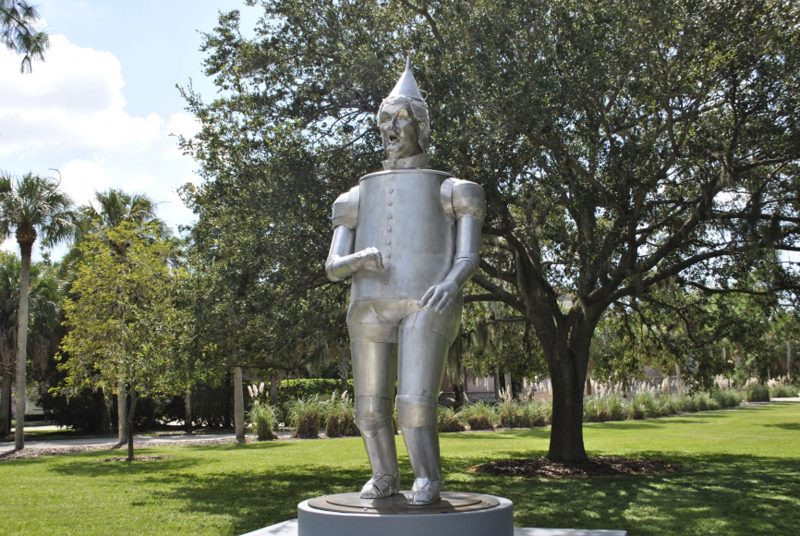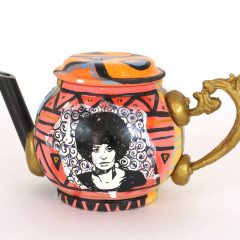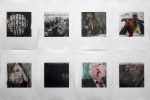
Tin Man of the Twenty-First Century, 2018
Aluminum and steel
© Coco Fusco/Artists Rights Society (ARS), New York
Cuban-American interdisciplinary artist and writer Coco Fusco (b. 1960) has often and controversially employed satire in her work as a means of cultural and political critique. Having earned multiple degrees in areas ranging from semiotics (the study of signs and symbols) to modern thought to art and visual culture, Fusco’s use of satire stems from her academic training. Well-versed in the mechanics of the genre on a rhetorical level, Fusco is keenly aware that satire, while conceptually and historically dense, is also accessible to a broad audience. Able to provoke both laughter and heated debate, Fusco makes use of satire’s paradoxical characteristics in her recent work, “The Tin Man of the Twenty-First Century” (2018), which lampoons President Trump and equates him to the heartless character from The Wonderful Wizard of Oz. Unveiled at The Ringling last year, Fusco’s work is currently on view at Art Basel. In a recent interview, conducted by email, Coco and I discuss her motivations for the striking sculpture, her interest in the genre of satire, art as activism, and her thoughts on the current state of affairs between America and Cuba.
Lacy Murphy: You recently stated in an interview with Wendy Vogel for Art Basel that satire is an effective means of lampooning people in power, especially demagogues in authoritarian states. Why is satire such an effective tool of resistance? What about the genre’s mechanics make it an incisive critical device?
Coco Fusco: I am not sure if satire is more effective than other strategies. What I have noted is that satire and parody are strategies frequently used by members of subaltern groups. Humor is often the only safe means of expressing criticism in a situation of oppression. I am thinking a range of scenarios: a feudal order in which the jester offers a veiled critique to a King, a colonial scenario in which the colonized lampoon their oppressors in a moment of carnival, or intellectuals and artists living in dictatorships that challenge the power structure with humorous extended allegories. Satire is also fun, and it’s usually quite accessible.
LM: As you have mentioned, satire is a thread that has run through much of your work. Are there any specific artists or writers that influenced you to begin working in this genre?
CF: I’m influenced by so many artists I don’t know where to begin. I did write my undergraduate thesis about Virginia Woolf’s Orlando, and I was thinking about parody as a feminist strategy then. I often talk about Jonathan Swift’s A Modest Proposal when I am teaching students about subversive rhetorical strategies. I did think about artists such as Honoré Daumier and even Komar and Melamid’s work in the former Soviet Union when I was working on “The Tin Man.”
LM: The monumental size of “The Tin Man” certainly leaves an indelible impression on the viewer. Its glorifying monumentality evokes the visually oppressive style associated with fascism – an aesthetic you said that you purposely co-opted for this work – however, its tawdry and cartoonish appearance elicits laughter at the same time. Some might categorize this work (and the nation’s current political circumstances) under comedy-horror. What kind of response do you hope to evoke from the viewer with this double-effect?
CF: Comedy-Horror? Sure, why not?
LM: You have been described as an artist-activist and your visual and written oeuvre certainly supports this title. Just recently you were denied entrance into Cuba for the Havana Biennale for joining with other artists in a campaign against the Cuban government’s crackdown on artistic expression. It’s been said that art cannot replace action. Do you agree with this assertion? Can art only supplement action? Or is artmaking an action itself?
CF: […] Making any kind of art involves actions. Some artworks consist exclusively of actions – i.e. performance. I think most of my artwork doesn’t fall into the category of activism insofar as it is not designed to provide direct support to a political goal. On the other hand, I have been involved in activist efforts without making art about the issues involved. While I am interested in some forms of socially engaged art practice, I find that art historical discourse that differentiates between fine art and activist art is often logically flawed, elitist, and designed to enforce a formalist idea that art must be disinterested in order to be valuable, while implying that activist art is simplistic propaganda.
Fine art that does not purport to engage with the social can and does nonetheless tacitly serves political goals – it supports elitist values, elevates the social status to its owners, and functions as an economic asset for institutions and collectors, etc. The art historians who traffic in notions of disinterestedness are frequently involved in producing interpretive discourses that work to increase economic value by guaranteeing authenticity and determining originality. High priced art also “acts” in the marketplace as a transformative force. I have no doubt, for example, that the high value placed on works by Frida Kahlo and Jean-Michel Basquiat have altered the perception and price of Mexican art and African-American art respectively.
When people in the art world call me an activist, they usually mean something negative. It means I am an upstart, that my values and aesthetics are not those of the mainstream, that my work doesn’t have lasting value, and that it doesn’t merit being in a major collection. It’s a sign of the sad state of art criticism that intelligent interpreters of art ignore my interest in language and performativity, my research on colonial archives, or my exploration of women’s work and agency.
I do not make agitprop art and I am not interested in producing propaganda for causes.
LM: President Trump recently banned so-called “people-to-people” and educational travel to Cuba, walking back policy changes made during the Obama administration. What is your position on these changes? What is at stake with increased constrictions on exchange between the two nations?
CF: […] I am wary of falling into the American trap of assuming that US policy determines everything about what happens in Cuba. I don’t support the Trump presidency or his policies. At the same time, I think the Obama administration’s policy of rapprochement was somewhat flawed in its assumption that increasing tourism and boosting the private sector would lead to political change in Cuba — while it did allow many Cubans to make hard currency, it also contributed to a backlash from the state against that growing independent sector and the autonomy that having one’s own money affords. And there are many examples of post-communist countries that have opened economically to capitalism but have not become more democratic.
Remember that Obama’s policies were in effect for only a couple of years. Cuba and the US have been at war with each other for sixty years and both sides are stuck in their stances. As for what is at stake – on the US side it is very simple – it’s the electoral votes in Florida, a state that is crucial for the Republican Party. The Cuban exile community is not a political monolith. Most recent immigrants and second and third generation Cuban-Americans are not hardline conservatives, but the majority of them don’t vote. The old guard hard liners have a well-oiled political machine.
Fusco has un upcoming solo exhibition at the Flaten Museum in Minnesota in the fall. Her most recent videos will also be featured in the Tate Modern’s film program in December.









